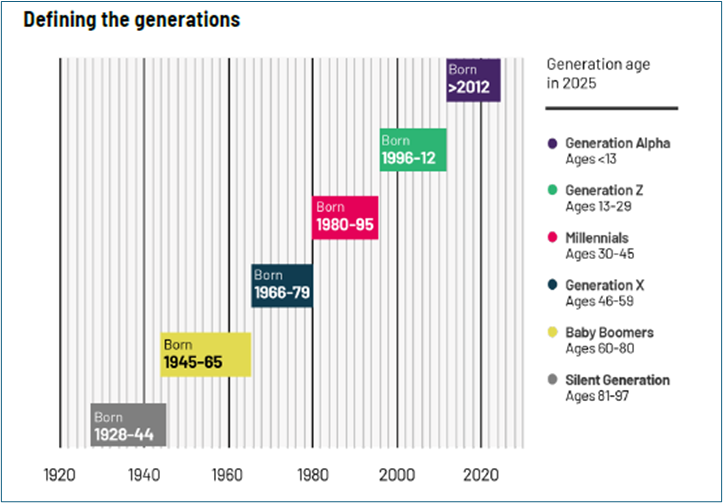Moving beyond generational stereotypes in marketing: is age just a number?
By Ipsos Belgium
When done properly, generational analysis can be a great tool for understanding how change happens in societies – and identifying new marketing opportunities. Let's dive into the key insights and misconceptions of 3 generations: Gen Z, Gen X and Baby Boomers - and explore how they can inform your marketing and communication strategies.
The danger of ‘Generational Generalizations’
It can be tempting to portray Gen Z as digital natives obsessed with TikTok, or Boomers as being out of touch. These are oversimplifications that ignore the rich tapestry of individual experiences and motivations that live within an age cohort. Attributing specific traits to entire age groups can lead to ineffective campaigns or products, and missed opportunities. To develop a more effective generational marketing strategy, we should understand the different dynamics at play defining the people in specific age groups:
- Be aware of life stage-related needs first: The most obvious, yet often overlooked in generational marketing: consider where your target groups are in their life journey. A young professional in Brussels has different priorities than a parent buying a first home. Marketing must speak to these immediate needs first. With people leading less linear lives and skipping traditional milestones, this awareness is more than ever important.
- Some trends are shaped by historical events, rather than by the new generation: Recognize the impact of shared historical events that shape attitudes and behaviors beyond particular age groups. The COVID-19 pandemic, for example, has reshaped consumer behavior across all age groups, leading to increased online shopping, a greater focus on health and well-being, and a renewed appreciation for community.
- True generational traits stem from unique formative experiences of one age cohort: This is where true generational differences lie. Identifying these requires careful analysis and longitudinal data. For example, Gen Z's inherent understanding of digital privacy stems from growing up in an era of data breaches and online surveillance, influencing their brand preferences and online interactions.

Gen Z (13-29y.o.): a fundamental divergence within Belgium's youngest consumers
While often treated as such, Gen Z is not a homogenous group. One striking finding is the growing divergence between young men and women on social issues. Young men are leaning towards conservative values, while young women are becoming increasingly progressive and liberal. For example, the Ipsos Global Trends study (2024) revealed that more young men believe most people should have children, than young women do (31% vs 17%). This divide is reflected in Gen Z’s fragmented media landscapes, creating echo chambers and reinforcing differing viewpoints. The effects are enormous, impacting the expectations towards government, employers and brands.
How to better connect with this cohort:
- Micro-targeted campaigns: Recognize the diverse viewpoints within Gen Z. A single campaign attempting to appeal to all Gen Z members is likely to fall flat. Consider tailoring content to specific interests and values within this generation. Utilize data analytics to identify micro-segments within Gen Z and deliver personalized messaging.
- Purpose and authenticity are key: What marks Gen Z across the board, is that they greatly value genuine connections and transparency. Brands should focus on building trust through honest communication and demonstrate a genuine commitment to making a difference.
- Embrace imperfection: Gen Z is rejecting the picture-perfect, polished marketing that millennials embraced. Raw, unfiltered content that feels real and relatable is more likely to resonate.

Gen X (46-59y.o.): Belgium's overlooked yet powerful consumers
They are often overlooked in favour of younger demographics, yet Gen X holds significant economic and leadership power. With executives now often working into their 60s and 70s, we can expect Gen X leaders to remain at the heart of business life for at least the next decade. In Europe, Gen X outnumbers Gen Z (20% vs. 18% of the population), making them a significant force in terms of market potential.
How to tap into the potential of this cohort:
- Don't ignore them: Gen X has significant consumer power and influence. They are often the primary decision-makers for household purchases and investments.
- Acknowledge their responsibilities: Many Gen Xers are part of the "sandwich generation," caring for both children and aging parents. Marketing messages should acknowledge their complex lives and offer solutions that simplify their responsibilities.
- Focus on value and reliability: This generation can appreciate quality products and services that meet its needs and stand the test of time. Emphasize durability, functionality, and long-term value.

Baby Boomers (60-80y.o.) : re-defining "Old"
The world is aging, and older adults are living longer, more active lives. The traditional view of "old age" is evolving, with people remaining engaged and empowered well into their later years. Seniors are redefining traditional life stages and embracing personal growth and fulfillment in later life, with a continuous focus on personal and professional development. Seniors are also increasingly tech-literate, challenging the stereotype of tech-averse elders. They are using technology to stay connected, access information, and manage their lives. Also, older generations are sometimes more progressive on social and environmental issues than younger generations!
How to include this increasingly engaged cohort:
- Challenge stereotypes: Avoid portraying older adults as frail, out of touch, or resistant to change. Instead, showcase their vitality, experience, and contributions to society.
- Promote accessibility: Ensure that products, services, and physical spaces are accessible to seniors with varying levels of mobility and physical ability. This includes clear signage and assistive technologies. Develop digital platforms and marketing campaigns that are user-friendly and accessible to older adults. Optimize websites and apps for larger font sizes, clear navigation, and voice-activated features. With the European Accessibility Act to become EU law on June 28th, this will become the norm.
- Highlight personal growth opportunities: Offer products and services that cater to their desire for lifelong learning, new experiences, and personal enrichment, like educational courses or hobby-related products.

So, is age just a number? Generational segmentation can offer a useful starting point for marketers, but don't let it be your final destination. Focus on life stages and individual needs to truly connect with your audience. By understanding the nature of the different dynamics at play that define people in a certain age bracket, we can build more effective campaigns and better products.
Reach out for more information:
Dorien.deckers@ipsos.com
Ipsos Belgium
View the full report >